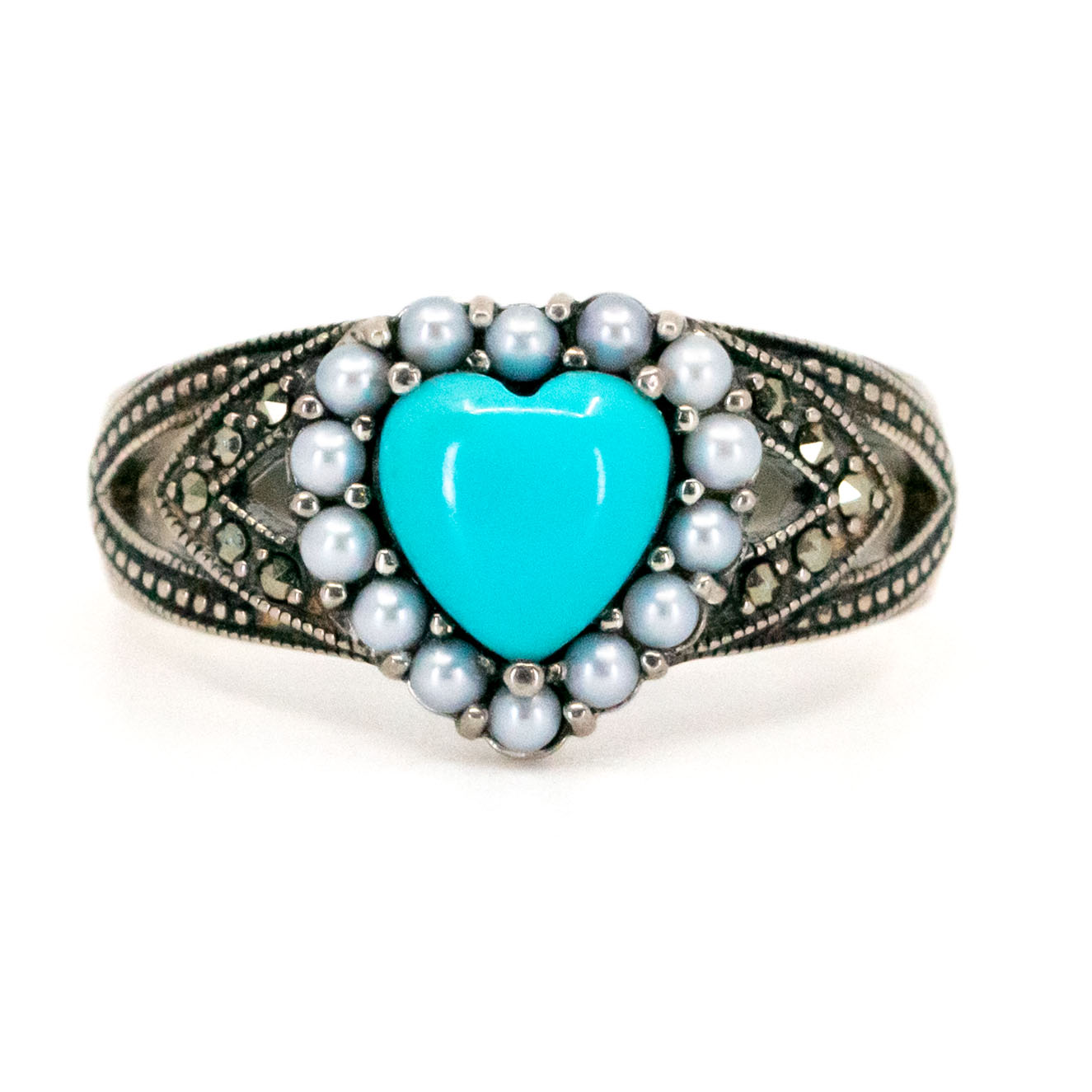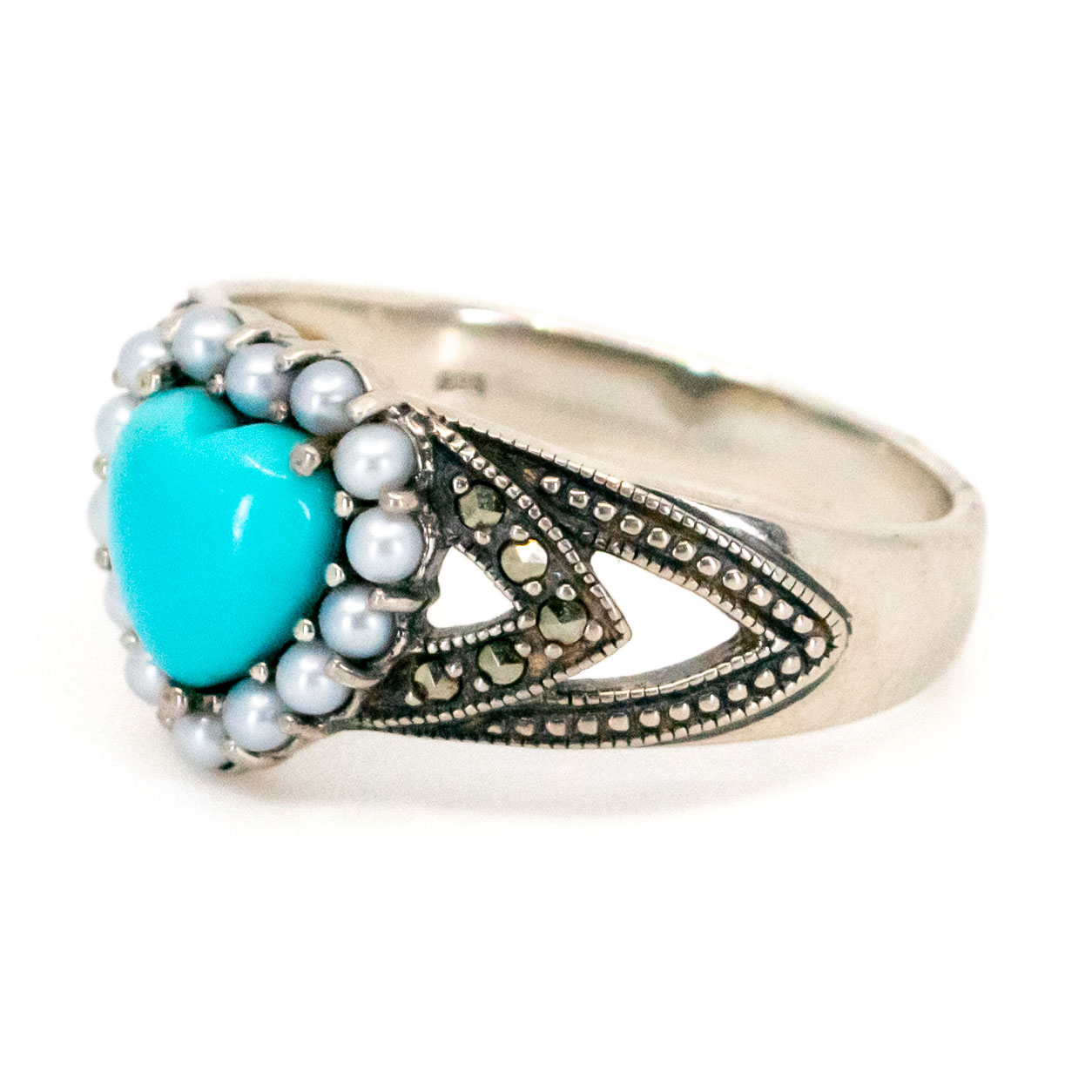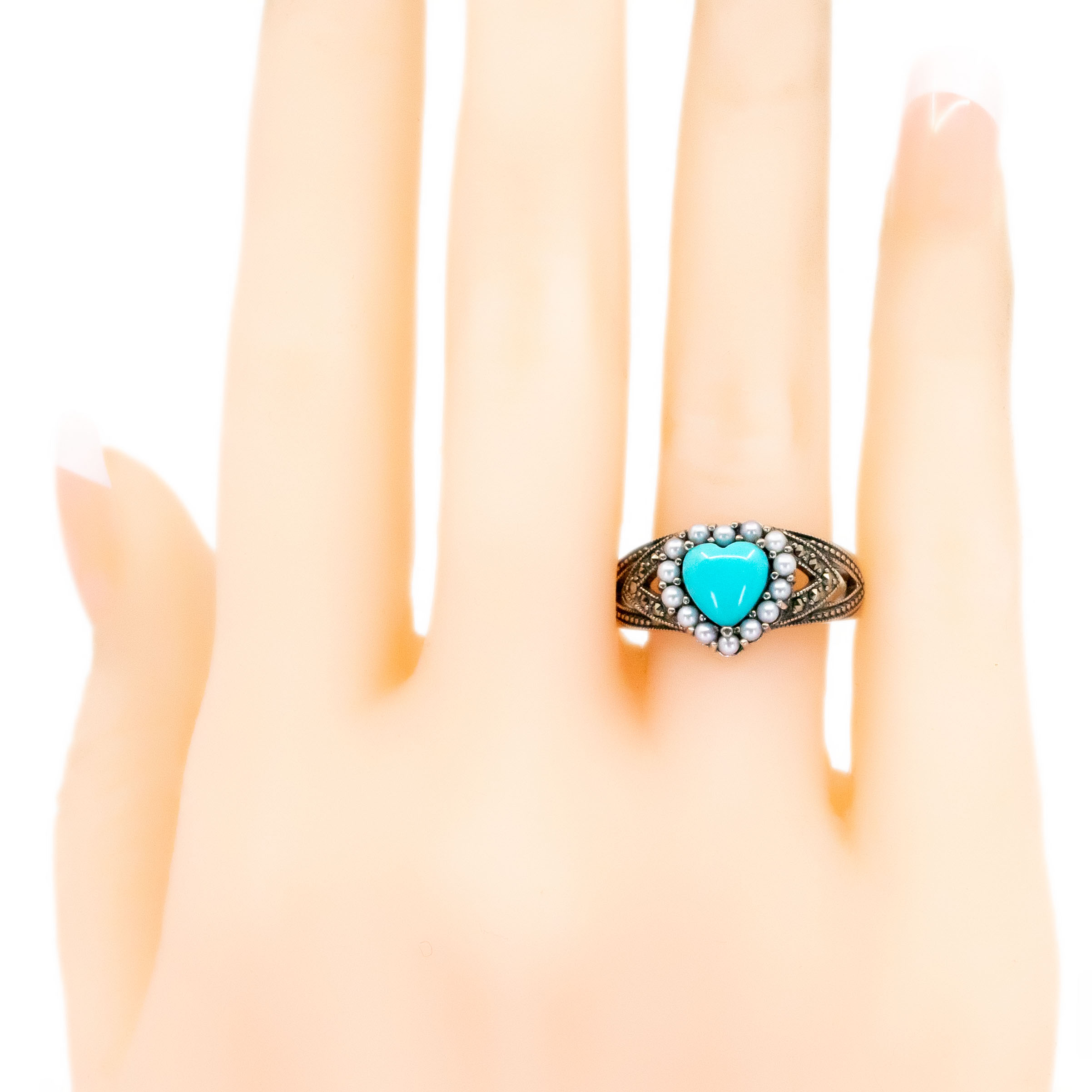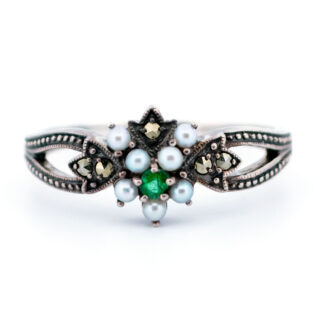This fine quality Victorian-design ring features heart-shaped turquoise surrounded by pearls and marcasite (pyrite), beautifully crafted in Silver.
Details: Turquoise, Pearls, Marcasite (pyrite), Silver Ring.
Design Era: New Victorian.
Weight in grams: 3.5.
Condition: New.
Shipping and Pickup: This fine quality piece ships from our store located in the center of Amsterdam, The Netherlands. We offer both registered shipping and local pickup at our store. In the case of local pickup, any applicable shipping costs will be refunded.
About Us: Add some sparkle to your style with Binenbaum.com. We offer a stunning selection of antique and vintage jewelry that you won’t find anywhere else. From timeless rings and dazzling necklaces to unique brooches, we have something for every taste and occasion. Visit our website today and treat yourself to a piece of history.
| Design Era | |
|---|---|
| Design & Historical Context | The Victorian Era spanned Queen Victoria's rule of England from 1837 until 1901. During this time, a middle class began to emerge, sparking a demand for jewelry in the mass market, jewelry trends often reflected the tone of current events. The era is usually divided into several subsections: the Romantic Period from 1837 to 1861, the Grand Period from 1861 to 1880, and the Aesthetic Period from 1880 to 1901. During the Romantic Period jewelry also featured nature-inspired designs, similar to jewelry of the Georgian era. Frequently, these designs were delicately and intricately etched into gold. Lockets and brooches were popular in daytime jewelry during the early Victorian era, whereas colored gemstones and diamonds were worn during the evening. During the Grand Period jewelry , because the Grand or Mid-Victorian era corresponded with the death of Queen Victoria's husband, many jewelry pieces have solemn, somber designs. Known as mourning jewelry, the pieces feature heavy, dark stones. Jet, onyx, amethyst, and garnet are frequently found in jewelry from this period. Compared to previous periods, Mid-Victorian-era jewelry features highly creative, colorful designs using shells, mosaics and gemstones. During the Aesthetic period, jewelers used diamonds and feminine, bright gemstones such as sapphire, peridot, and spinel. Star and crescent designs as well as elaborate hat pins were also popular. Some scholars believe the aesthetic era began sooner, in 1875, and ended as early as 1890. |
| Key Materials | |
| Materials & Craftsmanship | Turquoise: The Gem of Protection and Serenity Turquoise, with its striking blue-green hue, is one of the oldest known gemstones and has been cherished for thousands of years for its beauty and protective qualities. This opaque gem, often veined with black or brown matrix patterns, is composed of hydrous phosphate of copper and aluminum, which gives it its distinctive color. Historically, turquoise has held deep significance in various cultures. Ancient Egyptians adorned their pharaohs with turquoise jewelry, and it was often used in burial masks and other sacred items. Native American tribes have long revered turquoise as a powerful talisman for protection, healing, and good fortune, believing it could connect the wearer to the spirit world and enhance communication with the divine. In modern jewelry, turquoise is admired for its vibrant color and natural appeal. With a Mohs hardness of 5 to 6, turquoise is softer than many other gemstones, so it is often set in protective settings or used in larger, statement pieces such as rings, necklaces, and bracelets. Turquoise pairs beautifully with silver, which accentuates its earthy, natural tones, making it a popular choice in Southwestern and bohemian-style jewelry. Turquoise is more than just a gemstone; it is a symbol of protection, wisdom, and tranquility. Its rich history and serene color make it a timeless and cherished choice for jewelry that carries both beauty and deep cultural resonance. Pearl: The Gem of Elegance and Purity Pearls, with their natural luster and timeless beauty, are one of the most revered gemstones in the world. Unlike other gems, pearls are organic, formed within the soft tissue of mollusks like oysters and mussels. Their formation process results in a smooth, round gem with a soft, iridescent glow, often referred to as the "pearl essence." Historically, pearls have been a symbol of purity, wisdom, and wealth. In ancient Rome, they were considered the ultimate status symbol, while in ancient China, pearls were believed to protect against fire and dragons. During the Renaissance, pearls were so highly valued that they were reserved for royalty and nobility, symbolizing perfection and integrity. In modern jewelry, pearls are cherished for their classic elegance and versatility. They are commonly found in a range of colors, from the traditional white and cream to rare black, pink, and golden hues. Pearls are often strung into necklaces, set into earrings, or used as delicate accents in rings and bracelets. Their softness, with a Mohs hardness of 2.5 to 4.5, requires gentle care, but their beauty and sophistication are unmatched. Pearls are more than just a gem; they are a symbol of grace, purity, and timeless style. Their natural origins and understated elegance make them a beloved choice for jewelry that exudes refinement and sophistication. Marcasite (pyrite): The Gem of Timeless Elegance and Vintage Charm Marcasite, often mistakenly referred to as pyrite, is a gemstone that has captivated jewelry enthusiasts for centuries with its metallic luster and vintage appeal. Although marcasite is technically a form of pyrite, true marcasite jewelry is made from pyrite crystals that are cut and polished to create a shimmering, antique look. Historically, marcasite has been admired for its mysterious, reflective surface, often used in intricate, filigree designs during the Victorian and Art Deco periods. In the 18th and 19th centuries, it became particularly popular in Europe as a more affordable alternative to diamonds, lending an air of elegance and sophistication to brooches, rings, and other accessories. In modern jewelry, marcasite is prized for its ability to add a touch of vintage charm and drama to any piece. Its metallic, gunmetal-gray hue pairs beautifully with silver settings, and its natural sparkle makes it a standout in both understated and ornate designs. Marcasite is commonly seen in rings, earrings, pendants, and brooches, often set in sterling silver to enhance its classic, antique look. Marcasite is more than just a gemstone; it is a symbol of timeless elegance and enduring style. Its historical significance and unique, reflective quality make it a cherished choice for jewelry that exudes both character and sophistication, perfect for those who appreciate the charm of vintage-inspired designs. Silver: The Metal of Elegance and Versatility Silver, known for its bright, reflective luster, is one of the most beloved and widely used precious metals in the world. This versatile metal has been cherished for thousands of years, not only for its beauty but also for its malleability, making it ideal for crafting intricate and delicate jewelry designs. Historically, silver has been associated with the moon and considered a symbol of purity, clarity, and protection. Ancient civilizations, from the Egyptians to the Greeks and Romans, valued silver for its beauty and used it to create coins, jewelry, and religious artifacts. In many cultures, silver is also believed to have healing properties, often used in amulets and talismans to ward off negative energy. In modern jewelry, silver is prized for its affordability, versatility, and timeless appeal. Sterling silver, an alloy of 92.5% pure silver and 7.5% other metals (usually copper), is the standard used in high-quality jewelry. Its durability and bright, reflective surface make it an excellent choice for a wide range of designs, from minimalist pieces to ornate creations. Silver can be polished to a high shine or given a matte, oxidized, or antiqued finish to suit various styles. Silver is more than just a metal; it is a symbol of elegance, flexibility, and understated luxury. Its enduring popularity and wide-ranging applications make it a staple in jewelry that can complement any look, from casual to formal, with timeless grace. |
| Gender | |
| Weight (in grams) | 3.5 |
| Condition |
Enhance the Beauty of Your Jewelry with Proper Care
Wearing your jewelry is a special way to express yourself and add a touch of personal style to any look. However, to ensure your jewelry remains in pristine condition, there are a few simple steps you need to take to keep it looking its best.
General Care Instructions:
Remove jewelry when showering or bathing, especially when at the beach, in the sea or in chlorinated water.
Avoid wearing jewelry while doing physical work such as housekeeping, gardening or exercise.
Storing your jewelry in a dry and cool place will help protect it from moisture, dirt and dust.
Keeping it away from harsh chemicals such as bleach, ammonia and chlorine will help to avoid discoloration and damage.
Cleaning your jewelry regularly with a soft cloth will help to keep it looking shiny and new.
Avoid exposing your jewelry to extreme temperatures, such as leaving it in direct sunlight or near a heater, as this can cause damage.
Handle your jewelry carefully and avoid dropping it, as this can cause the stones to loosen or the metals to scratch.
Finally, if possible, have your jewelry professionally checked and serviced. This will ensure that any potential problems are spotted and fixed before they become worse.
By following these tips, you can enjoy your precious jewelry for many years to come.
Related Products
-
Onyx Pearl Turquoise Marcasite (Pyrite) Silver Ring 16062-2402
€ 225,00 VAT incl. (where applicable) -
Marcasite (Pyrite) Pearl Turquoise Silver Cluster Ring 15378-2128
€ 145,00 VAT incl. (where applicable) -
Garnet Marcasite (Pyrite) Pearl Silver Ring 16788-2686
€ 265,00 VAT incl. (where applicable) -
Marcasite (Pyrite) Pearl Silver Row Ring 16801-2699
€ 145,00 VAT incl. (where applicable) -
Emerald Marcasite (Pyrite) Pearl Silver Cluster Ring 16060-2400
€ 145,00 VAT incl. (where applicable) -
Marcasite (Pyrite) Pearl Silver Oval-Shape Ring 15365-2117
€ 165,00 VAT incl. (where applicable) -
Marcasite (Pyrite) Opal Pearl Silver Cluster Ring 15389-2139
€ 265,00 VAT incl. (where applicable) -
Garnet Marcasite (Pyrite) Pearl Silver Ring 9670-6411
€ 265,00 VAT incl. (where applicable)
- Home
- Collection
- Fine Jewelry
- Silver Jewelry
- Silverware
- Boxes
- Candlesticks
- Salt and pepper shakers
- Miniatures
- Salt cellars
- Spoon Set
- Condiments
- Frames
- Napkin Ring
- Spoon
- Oddities
- Cups
- Vases
- Cutlery
- Serving Spoon And Cake Server
- Candlesticks
- Baskets
- Hanukkiah
- Spice Tower
- Yad
- Tea Set
- Sugar Castor
- Napkin Rings
- Wine Bottle Coaster
- Wine Stopper
- Tea Pot
- Jugs
- Rattles
- Hip Flask
- Miscellaneous
- Rings 💍
- About
- Contact


















